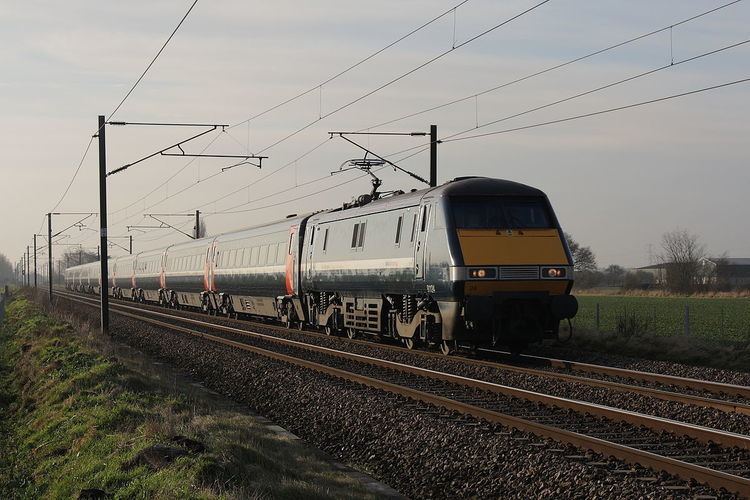Power type Electric Total produced 31 nine-carriage units | Build date 1988—1991 | |
 | ||
Builder BREL, GEC-Alsthom, Metro Cammell UIC class Bo′Bo′+2′2′+...+2′2′+2′2′ Maximum speed 140 mph (225 km/h) (Design)125 mph (201 km/h) (Service)161.7 mph (260.2 km/h) (Record) | ||
The InterCity 225 is an electric high speed train in the United Kingdom, comprising a Class 91 electric locomotive, nine Mark 4 coaches and a Driving Van Trailer. The Class 91 locomotives were built by BREL at Crewe works as a spin-off from the Advanced Passenger Train project, which was abandoned during the 1980s, whilst the coaches and DVT were constructed by Metro-Cammell in Birmingham and Breda (under sub-contract) in Italy — again borrowing heavily from the Advanced Passenger Train. The trains were designed to operate at up to 140 mph (225 km/h) in regular service, but are limited to 125 mph (200 km/h) principally due to a lack of cab signalling and the limitations of the current overhead line equipment (OLE). They are used on services from London King's Cross to Leeds, Edinburgh Waverley, Glasgow Central, Skipton, Bradford Forster Square, Newark North Gate, York and Newcastle.
Contents
Service history
The InterCity 225 entered service with British Rail on the East Coast Main Line in 1990. The units also operate on a small section of the West Coast Main Line between Glasgow and Carstairs. In 1996, as part of the privatisation of British Rail, all InterCity 225s were sold to Eversholt Rail Group, which currently leases them to Virgin Trains East Coast.
The InterCity 225 has a top service speed of 140 mph (225 km/h); during a test run on Stoke Bank between Peterborough and Grantham an Intercity 225 reached 161.7 mph (260.2 km/h). However, except on High Speed 1, which is equipped with cab signalling, British signalling does not allow trains to exceed 125 mph (201 km/h) in regular service, due to the impracticality of correctly observing lineside signals at high speed.
Between 2001 and April 2006, HSBC Rail (IC225 owner, now Eversholt Rail Group) initiated and funded with support from GNER and Bombardier Transportation and Alstom and others a complete rebuilding and refurbishment programme for both the Class 91 and Mark 4 coaches, called Project Mallard.
Capacity and Formation
The formation of the InterCity 225 sets is below:-
The total numbers of seats are 406 Standard and 129 First, giving the train an overall capacity of 535 seats.
Replacements
The finalised £4.5 billion contract for the Intercity Express Programme trains for the Great Western Main Line and East Coast Main Line (ECML) was announced in July 2012. Capital costs for the vehicles are approximately £2.8 million per carriage for bi-mode versions and £2.4 million per carriage for electric versions. Financial closure was reached on the first phase of the contract, valued at £2.4bn, consisting of 21 nine-car electric (Class 801) and 36 five-car bi-mode trains (Class 800), 369 carriages total, for use on Great Western routes.
The second phase of the contract consisted of 10 five-car and 13 nine-car bi-mode and 12 five-car electric units (227 carriages) for use on the ECML; financial closure on the second phase was expected in 2013. A £1.2bn option for further 30 nine-car electric trains (270 carriages) to replace Intercity 225 sets on the ECML was taken up on 18 July 2013.
The trains will enter service in 2017 on the Great Western Main Line and 2018 on the East Coast Main Line.
